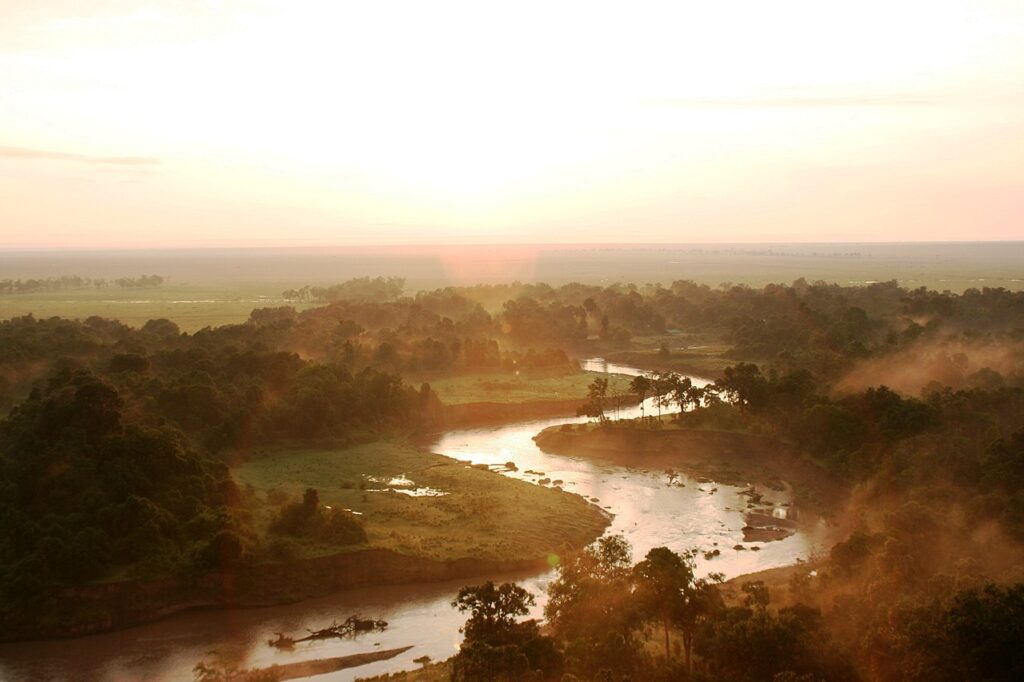As far as the eye could see, in their thousands and tens of thousands, the wildebeest came.
Stringing down from the smooth yellow hills like ants in a single file, they stopped and waited at on the bank of the Mara river in their uncounted masses. Below, the ancient crocodiles were waiting in the swift brown water, faces set in a sardonic, reptilian grin.
They were ready.
The great mass milled about, nervously watching the far bank. None wanted to be the first to go. They had no choice.
And still, the multitudes kept streaming down from the low hills, heads low, moaning softly. They joined the throng and waited.
Suddenly an old male, the patchy skin smooth and grey with age, leaped far out into the river. It was the signal.
Like a flock of birds, moving together with choreographed instinct, the masses began to cross. Pushed from the back, the animals in the front were forced over the bank and into the water – where the giant reptiles waited patiently.
The crossing had begun.
No television programme – no matter how carefully edited and eloquently narrated – can describe being in the middle of the pandemonium and action of the crossing. The bleats, the dust, the river, the death – all combining to create the greatest spectacle I have ever seen.
This is one of the greatest natural spectacles in the world. The annual movement of massive herds of wildebeest continues year-round in Tanzania’s Serengeti National Park and Kenya Masai Mara National Reserve.
Great Migration Movements
December to May
For the wildebeest, only one place is truly home – the short grass plains of the southern Serengeti, from Lake Nduni to the Ngorongoro Conservation Area. This is where they are born and where they seek to return whenever there is plentiful grazing. From December up to May, once the November rains create ample grazing, up to two million wildebeest can be found here.
April – June
The herds disperse throughout the central Serengeti, heading mostly in a north-western direction, towards the Western Corridor and the Grumeti River. Some will travel directly north, towards Seronera, while a few leave the Serengeti altogether.
June – July
The wildebeest encounter the first major obstacle in their quest – the Grumeti River. In dry years, the river is reduced to a series of pools and the herds can easily pick their way between the hippos and crocodiles in their depths. In wet years, the wildebeest are forced to plunge headfirst into waters inhabited by some of Africa’s largest crocodiles.
July – September
The herds head north towards the lush plains of the northern Serengeti and the Masai Mara. The next set of spectacular river crossings takes place at the Mara River any time between July and October. Hundreds of thousands of wildebeest may congregate on the banks of the river, gazing dreamily at the green grass on the other side but not one will make a move.
October
Most of the wildebeest are now in Kenya’s Masai Mara, although some still remain in the Serengeti. As the rains shift from east to west, the herds may cross the Mara River repeatedly, following the life-giving rains and the green grass that springs up after them.
November
The herds now return to the place of their birth, the grassy plains of the southern Serengeti. Unlike their previous movements, the wildebeest do not wander off in smaller groups, but depart suddenly in a concerted movement, arriving in the south within just a few weeks.
December
By mid-December, almost two million wildebeest will have returned to the short grass plains of the southern Serengeti.
We flew to Nairobi where we visited Karen Blixens’s home and ate impala, zebra, eland and other meats at the famous Carnivore restaurant. After sleeping over at the Nairobi Serena we took a charter to the small Mara airstrip.
Kichwa Tembo
We overnighted at the luxurious Kichwa Tembo tented camp. Translated, it means The Place of the Elephant) and it has been immortalised through famous tales of an olden day Masai Mara safari.
Kichwa Tembo lies directly in the path of the Great Migration making it an ideal destination for the ultimate Masai Mara safari.
The Masai Mara National Reserve is one of the richest and most diverse wildlife areas in the world. Known as the ‘spotted land’ to the Maasai, the reserve is home to a vast number of resident wildlife, as well as part of the annual phenomenon of the Great Migration.
The migratory wildebeest, zebra, kongoni, and topi join abundant elephant, hippo, buffalo, giraffe, lion, and cheetah in the Mara. Leopard and serval are frequently encountered, while endangered black rhino can be found in the dense bush thickets.
The Masai Mara National Reserve is part of a huge conservation area that also includes the Serengeti National Park and the Ngorongoro Conservation Area in neighbouring Tanzania. With no fences or man-made barriers, wildlife can move freely throughout this area, constantly recreating an ageless natural cycle.
Go and see the migration.
Borrow money if you must. Take the ones you love and just go.
You can always get more money – but you can never borrow more time

